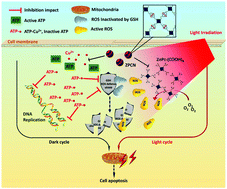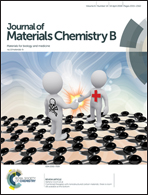A smart copper-phthalocyanine framework nanoparticle for enhancing photodynamic therapy in hypoxic conditions by weakening cells through ATP depletion†
Abstract
Hypoxia in solid tumors hinders the efficacy of photodynamic therapy (PDT). The route of generation of adenosine triphosphate (ATP) in hypoxic tumor cells comprises ineffective glycolysis processes, but ATP is crucial for rapid and uncontrolled growth and division. ATP depletion would inhibit DNA replication and glutathione (GSH) biosynthesis, which could inhibit the proliferation of cells and make them sensitive to PDT treatment. In this context, a nanoscale metal–organic framework nanoparticle consisting of Cu2+ and carboxyl-modified zinc phthalocyanine (ZnPc-(COOH)8) ({Cu8(ZnPc-(COOH)8)}n, ZPCN) was designed and prepared. In the dark cycle, ATP could remove Cu2+ from ZPCN and form a copper–ATP complex. ATP in the above complex could be destroyed by a copper-mediated Fenton reaction, which could finally induce ATP depletion to inhibit the proliferation of cells and make them sensitive to PDT treatment. In the light cycle, ZPCN could generate abundant cytotoxic reactive oxygen species to suppress tumor growth. These results demonstrated the potential applicability of the new strategy for achieving tumor treatment in hypoxic conditions by PDT.



 Please wait while we load your content...
Please wait while we load your content...